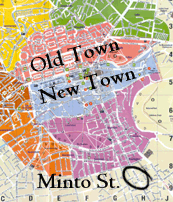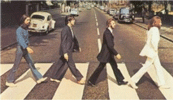
|
|
|||||||||
| Getting Around | ||
 Map of Edinburgh, click to enlarge, |
Edinburgh is actually a rather large city, but no worries, the part you probably care about is rather small. Most of the attractions are in the Old Town and the New Town, which are conveniently next to each other. | |
| The castle is outside Bonnyrigg, which is 8 miles southeast of Edinburgh. From Bonnyrigg, the castle is about 2 miles. The bus system goes from Edinburgh to Bonnyrigg, but not to the castle. It's best to catch a taxi from Edinburgh, which will run you about £12-15 (~$19-24) from Minto St. | ||
|
Buses Edinburgh has a very good public bus system, but it can be a bit confusing at first. There are several bus companies that run routes around the city, and bus passes for one are not valid on the others. |

|
|
| We used Lothian Buses exclusively on our stay, since it operates the most routes between Minto Street and the city center (indeed, it appeared to run buses along all the major tourist routes). The fare system can be a bit confusing, as it is calculated according to the number of stops, and it requires correct change. In order to avoid the hassles, we recommend buying a bus pass. Daily passes cost £2.50 (~$4) (or £1.80 [~$3] if purchased after 9:30am), and can be purchased from the bus driver. Weekly passes cost £11 (~$18), and are available from the Lothian Bus Office on Waverly Bridge (across the street from where the Airlink bus drops off!). The passes are good on all Lothian Buses except the Airlink bus and the Night Buses. Here is a map of the Edinburgh bus system. | ||
| Most bus routes run from 5am to midnight. Lothian Bus runs Night Buses on major routes between midnight and 5am. The fare per ride is £2 (~$3.20), or £1 (~$1.60) with a weekly pass. | ||
| The other major bus company in Edinburgh is First Edinburgh. Its website appears to be under construction, so we have very little information about First buses. We didn’t find it necessary to use them, anyway. | ||

|
Walking The city center (Old Town and New Town) is fairly compact and walkable, though somewhat hilly. Many of the streets are cobblestone (though the sidewalks are concrete), so wear sensible shoes when out exploring the city. |
|
| When crossing the street, remember that the traffic drives on the left, so be careful to look left, as well as right, before proceeding. There are often handy guides saying “look left” or “look right” painted on the curb. We found this amusing, as well as helpful. Also, there are two types of crosswalks – those with signals and those with only “zebra crossings” painted on the pavement. At the signal crossings, you have the right of way when the little man is green, and you don’t when the man is red. (If the little man is flashing, do not start crossing the street – he will turn red very, very shortly, and traffic will start moving immediately. Unlike U.S. walk signals, there is no built-in margin of error.) At zebra crossings, you always have the right of way, and cars will generally stop as soon as you step off the curb. If you do not have the right of way, motorists will merrily run over you. Be very careful. | ||
|
Taxis Taxis are readily available in Edinburgh. Those staying in Midlothian may wish to ask their hotel desk or B&B proprietor to call for a taxi. |

|
|
| There are two types of taxis in Edinburgh; the city taxis are big, usually black, funny-looking cars. There are also private car hire places; they tend to have more normal-looking cars. As far as we could tell, they cost about the same. The only difference is that you hail a black city taxi, and you call for a private car hire. So, for instance, you might take a city taxi to the castle, but you would have to call a car hire service to get back to Edinburgh. | ||

|
Trains The trains are one of the best ways to travel between cities in the UK. For more information (including maps and timetables), see BritRail. Or, for travel between Scottish cities, see ScotRail. |
|